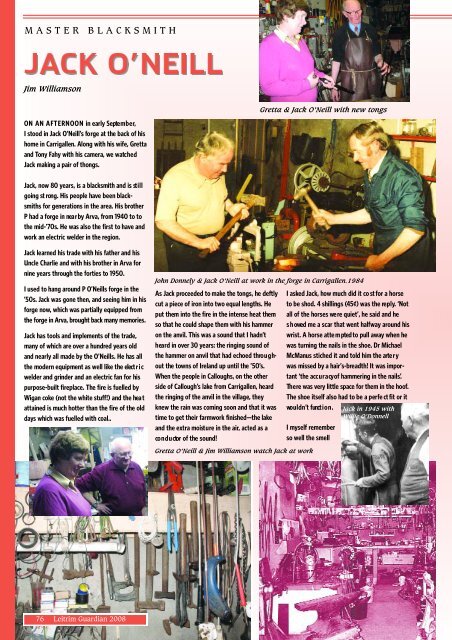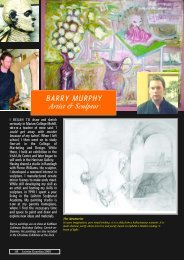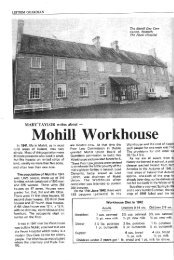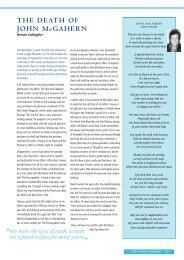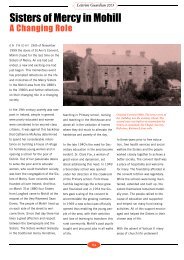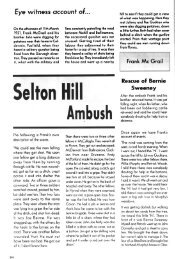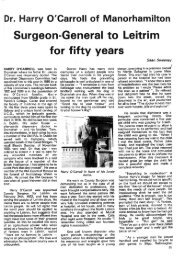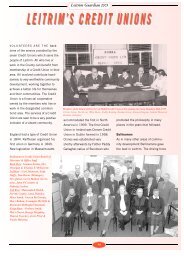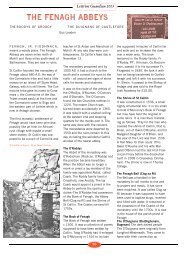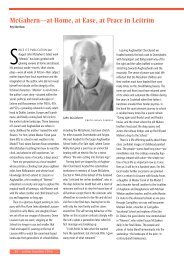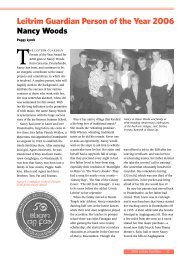Master Blacksmith Jack O'Neill - Leitrim Guardian
Master Blacksmith Jack O'Neill - Leitrim Guardian
Master Blacksmith Jack O'Neill - Leitrim Guardian
Create successful ePaper yourself
Turn your PDF publications into a flip-book with our unique Google optimized e-Paper software.
M A S T E R B L A C K S M I T H<br />
Jim Williamson<br />
Gretta & <strong>Jack</strong> O’Neill with new tongs<br />
ON AN AFTERNOON in early Septe m b e r,<br />
I stood in <strong>Jack</strong> O’Neill’s fo rge at the back of his<br />
home in Carrigallen. Along with his wife, Gret t a<br />
and Tony Fahy with his camera, we watc h e d<br />
<strong>Jack</strong> making a pair of thongs.<br />
<strong>Jack</strong>, now 80 years, is a blacksmith and is st i l l<br />
going st rong. His people have been blacksmiths<br />
for generations in the area. His brot h e r<br />
P had a fo rge in nea r by Arva, from 1940 to to<br />
the mid-’70s. He was also the first to have and<br />
work an electric welder in the re g i o n .<br />
<strong>Jack</strong> learned his trade with his father and his<br />
Uncle Charlie and with his brother in Arva fo r<br />
nine years through the forties to 1950.<br />
I used to hang around P O’Neills fo rge in the<br />
’50s. <strong>Jack</strong> was gone then, and seeing him in his<br />
fo rge now, which was partially equipped fro m<br />
the fo rge in Arva, brought back many memories.<br />
<strong>Jack</strong> has tools and implements of the trade,<br />
many of which are over a hundred years old<br />
and nearly all made by the O’Neills. He has all<br />
the modern equipment as well like the elect r i c<br />
welder and grinder and an electric fan for his<br />
purpose-built fire p l a ce. The fire is fuelled by<br />
Wigan co ke (not the white stuff!) and the hea t<br />
attained is much hot ter than the fire of the old<br />
d a ys which was fuelled with co a l ..<br />
John Donnely & <strong>Jack</strong> O’Neill at work in the forge in Carrigallen.1984<br />
As <strong>Jack</strong> pro ceeded to make the tongs, he deftly<br />
cut a piece of iron into two equal lengths. He<br />
put them into the fire in the intense heat them<br />
so that he could shape them with his hammer<br />
on the anvil. This was a sound that I hadn’t<br />
h ea rd in over 30 years: the ringing sound of<br />
the hammer on anvil that had echoed thro u g h-<br />
out the towns of Ireland up until the ’50’s .<br />
When the people in Calloughs, on the ot h e r<br />
side of Callough’s lake from Carrigallen, hea rd<br />
the ringing of the anvil in the village, they<br />
knew the rain was coming soon and that it was<br />
time to get their farmwork finished—the lake<br />
and the extra moist u re in the air, acted as a<br />
co n d u ctor of the sound!<br />
I asked <strong>Jack</strong>, how much did it co st for a horse<br />
to be shod. 4 shillings (45¢) was the re p l y. ‘Not<br />
all of the horses we re quiet’, he said and he<br />
s h owed me a scar that went halfway around his<br />
w r i st. A horse atte m pted to pull away when he<br />
was turning the nails in the shoe. Dr Michael<br />
McManus stiched it and told him the arte r y<br />
was missed by a hair’s - b readth! It was important<br />
‘the acc u r a cy of hammering in the nails’.<br />
Th e re was very little space for them in the hoof.<br />
The shoe itself also had to be a perfe ct fit or it<br />
wo u l d n ’t funct i o n .<br />
I myself re m e m b e r<br />
so well the smell<br />
<strong>Jack</strong> in 1945 with<br />
Willie O’Donnell<br />
Gretta O’Neill & Jim Williamson watch <strong>Jack</strong> at work<br />
76 <strong>Leitrim</strong> <strong>Guardian</strong> 2008
Hugh O’Neill, <strong>Jack</strong> O’Neill at<br />
12 years old and his Uncle<br />
Charlie. This picture taken at<br />
the original forge in<br />
Carrigallen where McCanns<br />
supermarket now stands.<br />
of the hooves as the hot shoes we re mea s u re d<br />
a g a i n st them to e n s u re that they we re level and<br />
the smell of the horsehair burning and the oil that<br />
the blacksmith used to paint the hooves to give<br />
them a nice finish. Many of these blacksmiths had<br />
a great rapport with the horses, but they got lots<br />
of abuse to o, both from the horses and their ow n e r s .<br />
<strong>Jack</strong> remembers John Duffy ’s Circus in the ’40s<br />
and all the wagons we re pulled by horses. Fo rg e s<br />
we re full of circus horses all day. ‘John Duffy<br />
made up the area’, acco rding to <strong>Jack</strong>. He bought<br />
p l e n ty of hay, oats and grain, food for the big<br />
ca ts, hard w a re items and supplies for the st af f.<br />
The big four wheel circus wagons we re pulled by<br />
P H O T O S I N J A C K O ’ N E I L L S F O R G E 2 0 0 4 & 2 0 0 7 (Sept) : T O N Y F A H Y<br />
USING THE FO RGE IN CARRIGA L L E N<br />
This account by Declan Tierney, was published in<br />
The <strong>Leitrim</strong> Observer in Sept 1984<br />
T R A D I T I O N S in a place are not easily broken and no<br />
place is this more evident than in Carrigallen where<br />
<strong>Jack</strong> O’Neill contents himself in pursuing that age old<br />
occupation of a blacksmith.<br />
Even in these days of electric welders and the like,<br />
there is something distinctly appealing about the<br />
furnace and the bellows that heat the metal until it is<br />
nearly liquefied.<br />
<strong>Jack</strong> O’Neill is by no means new to the business as<br />
his great, great grandfather, John O’Neill was also a<br />
blacksmith and the tradition has been handed down<br />
through generations.<br />
<strong>Jack</strong> still does business in repairs for a few people<br />
around the area and mostly concentrates on repairing<br />
machinery or other metal items. He built the furnace<br />
himself along with the water trough beside it to cool<br />
down the metal. But instead of using the time co n s u m-<br />
i n g puffing bellows which were responsible for a lot<br />
of arm muscles in its time, <strong>Jack</strong> uses a double blast<br />
electric fan to increase the strength of the fire.<br />
The process he told me for joining two pieces of<br />
iron together is to first prepare them by cleaning off<br />
any dust or dirt to ensure a perfect joint. Then you<br />
scarf the two pieces, which means that you cut a slice<br />
off each one in order to, basically, graft them together.<br />
When the two pieces of iron are ready to drip with hea t<br />
in the furnace, they are joined by putting one gently<br />
on top of the other. They are then hammered together<br />
and smoothed with a rounding iron. The perfect joint<br />
is achieved when the graft cannot be noticed.<br />
The making of loy-iron and horse shoes were the<br />
big business with a blacksmith. The loy was originally<br />
used for ploughing and often farmers had to face into<br />
a few acres of land with just a simple loy in their possession<br />
with which to plough with.<br />
The implements used in making a horseshoe were a<br />
fuller, which made the tracks on the shoes, the stamp,<br />
which was used to bore holes for the nails while<br />
pritchel was used to finish off around the nail holes.<br />
<strong>Jack</strong> O’Neill is a qualified blacksmith as he served<br />
his time with his brother for nine years in Arva. At the<br />
moment he turns his hand to doing a few welding jobs<br />
whenever he is approached, but he is otherwise occupied<br />
with his thriving electrical shop in the town.<br />
<strong>Jack</strong> believes that, even though technology has<br />
taken over with the electric welder, there is still quite<br />
a lot of business to be done with the old furnace if he<br />
had the time and farmers especially seem to have<br />
more confidence in the blacksmith where they could<br />
come and watch a job being done and they can identify<br />
with it better than an electric machine.<br />
There were five blacksmiths in Carrigallen at one<br />
stage and there were loads of work for all of them.<br />
Indeed, if one were to seriously concentrate on doing<br />
work with the furnace even now, there would be<br />
plenty for him to do, <strong>Jack</strong> told me.<br />
“The reason I have rebuilt this forge is to show my<br />
kids how it was all done when I was a young lad,” he<br />
explained.<br />
M etal frames for cart wheels we re also a popular ite m<br />
that needed repairing and <strong>Jack</strong> showed me some sa m p l e s<br />
of joints that he did and how to make a frame. He said<br />
that there is another blacksmith in Carrigallen also<br />
who is still working the forge and he is Pakie Maguire.<br />
“People who have worked on an old forge are well<br />
co m p etent to work an electric we l d e r,” concluded <strong>Jack</strong>.<br />
2008 <strong>Leitrim</strong> <strong>Guardian</strong> 77
78 <strong>Leitrim</strong> <strong>Guardian</strong> 2008
Left: Inside the forge<br />
in Carrigallen<br />
Above: Working on the<br />
tongs.<br />
Right: The O’Neill,<br />
Hardware & Electrical<br />
shop in Carrigallen.<br />
Dec 2000.<br />
Far Right: <strong>Jack</strong> with<br />
two long spades that<br />
he has just made.<br />
P HOT OS: TO NY FA H Y<br />
horses and some of these included Lion and<br />
Tigers, who seemed to watch eve r yone inte n t l y<br />
as they passed.<br />
Many blacksmiths at that time made the rims<br />
for the ca r twheels and also the blades for the<br />
ploughs that the draught horses pulled. To d a y,<br />
<strong>Jack</strong> still makes fine spades, tongs, hand-loys ,<br />
slans and other items for the home such as<br />
w a ter keys, co o ke r-lid lifters, ash box lifte r s<br />
and solid fuel stove openers.<br />
In 1950, <strong>Jack</strong> went to England and wo r ked for a<br />
year in a copper mill in Cove n t r y. Af ter he<br />
returned, he went to Smiths garage in Cavan<br />
(their cousin), with his Uncle Charlie and<br />
bought a new Fe rguson 20 tracto r, tvo fuelled,<br />
for £444 including plough and tailor-made<br />
canvas cove r.<br />
<strong>Jack</strong> wo r ked up the country in <strong>Leitrim</strong> for five<br />
years and soon got a mowe r, a threshing mill<br />
and later a diesel Fe rguson. He mostly wo r ke d<br />
in the Ballinamore and Carrigallen areas and<br />
of ten wo r ked through the night by the lights<br />
that he had fixed up on the tracto r. And yet<br />
when the tractors came in, it signalled the<br />
demise of the blacks m i t h .<br />
In 1956, <strong>Jack</strong>’s Uncle Charlie died suddenly and<br />
his Aunt wanted him to take over in Carrigallen.<br />
He opened a hard w a re sto re in 1957 and also<br />
sold implements from the fo rge as his uncle<br />
had done. <strong>Jack</strong> married Gretta Dolan from<br />
B a l l i n a m o re in 1970. They rea red two sons,<br />
Hugh O’Neill, a solicitor and fluent Spanish<br />
s p ea ke r, living on the Iberian peninsula and<br />
Pete r, an accountant working and living in<br />
Dublin. In 1977, <strong>Jack</strong>’s brother P who was<br />
s even years older than him, died af ter an<br />
illness.<br />
<strong>Jack</strong> continued working at his trade and<br />
running the business until 2004 when he<br />
closed the hard w a re shop and ret i red fro m<br />
business. As well as his fo rge wo r ks h i p,<br />
<strong>Jack</strong> does plenty of gardening and re m a i n s<br />
a ct i ve. May he have many years of good<br />
fortune ahead of him.<br />
2008 <strong>Leitrim</strong> <strong>Guardian</strong> 79


